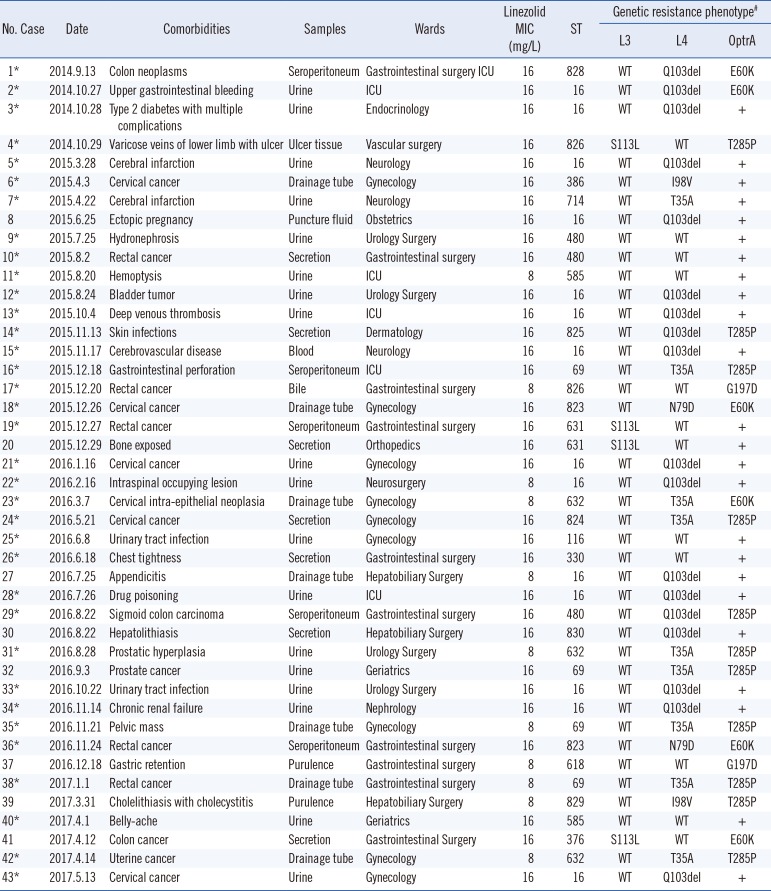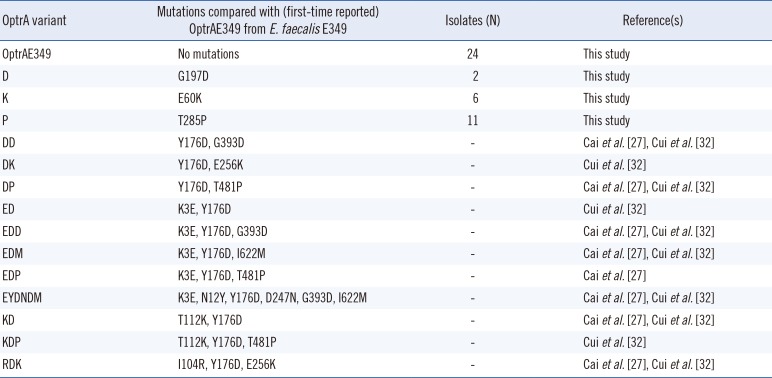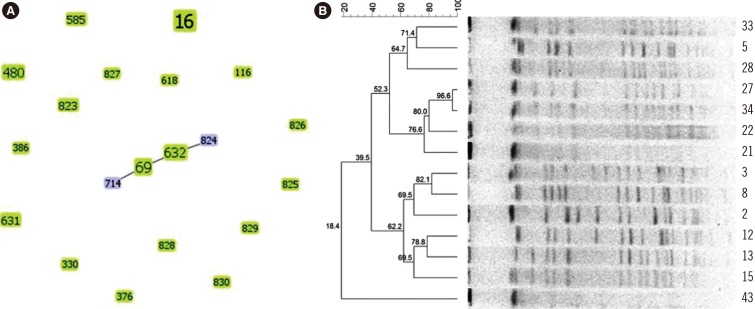1. Kloss P, Xiong L, Shinabarger DL, Mankin AS. Resistance mutations in 23 S rRNA identify the site of action of the protein synthesis inhibitor linezolid in the ribosomal peptidyl transferase center. J Mol Biol. 1999; 294:93–101. PMID:
10556031.
2. Mendes RE, Deshpande LM, Jones RN. Linezolid update: stable
in vitro activity following more than a decade of clinical use and summary of associated resistance mechanisms. Drug Resist Updat. 2014; 17:1–12. PMID:
24880801.
3. Bonilla H, Huband MD, Seidel J, Schmidt H, Lescoe MK, McCurdy SP, et al. Multicity outbreak of linezolid-resistant
Staphylococcus epidermidis associated with clonal spread of a cfr-containing strain. Clin Infect Dis. 2010; 51:796–800. PMID:
20726771.
4. Wong A, Reddy SP, Smyth DS, Aguero-Rosenfeld ME, Sakoulas G, Robinson DA. Polyphyletic emergence of linezolid-resistant staphylococci in the United States. Antimicrob Agents Chemother. 2010; 54:742–748. PMID:
19933808.
5. Chen H, Wu W, Ni M, Liu Y, Zhang J, Xia F, et al. Linezolid-resistant clinical isolates of enterococci and
Staphylococcus cohnii from a multicentre study in China: molecular epidemiology and resistance mechanisms. Int J Antimicrob Agents. 2013; 42:317–321. PMID:
23880167.
6. Diaz L, Kiratisin P, Mendes RE, Panesso D, Singh KV, Arias CA. Transferable plasmid-mediated resistance to linezolid due to cfr in a human clinical isolate of
Enterococcus faecalis. Antimicrob Agents Chemother. 2012; 56:3917–3922. PMID:
22491691.
7. Wang Y, Lv Y, Cai J, Schwarz S, Cui L, Hu Z, et al. A novel gene,
optrA, that confers transferable resistance to oxazolidinones and phenicols and its presence in
Enterococcus faecalis and
Enterococcus faecium of human and animal origin. J Antimicrob Chemother. 2015; 70:2182–2190. PMID:
25977397.
8. Cai J, Wang Y, Schwarz S, Zhang G, Chen S, Gu D, et al. High detection rate of the oxazolidinone resistance gene
optrA in
Enterococcus faecalis isolated from a Chinese anorectal surgery ward. Int J Antimicrob Agents. 2016; 48:757–759. PMID:
27751624.
9. Sharkey LK, Edwards TA, O'Neill AJ. ABC-F proteins mediate antibiotic resistance through ribosomal protection. MBio. 2016; 7:e01975-15. PMID:
27006457.
10. Jones RN, Ross JE, Bell JM, Utsuki U, Fumiaki I, Kobayashi I, et al. Zyvox Annual Appraisal of Potency and Spectrum program: linezolid surveillance program results for 2008. Diagn Microbiol Infect Dis. 2009; 65:404–413. PMID:
19913683.
11. Ross JE, Farrell DJ, Mendes RE, Sader HS, Jones RN. Eight-year (2002-2009) summary of the linezolid (Zyvox® Annual Appraisal of Potency and Spectrum; ZAAPS) program in European countries. J Chemother. 2011; 23:71–76. PMID:
21571621.
12. Patel SN, Memari N, Shahinas D, Toye B, Jamieson FB, Farrell DJ. Linezolid resistance in
Enterococcus faecium isolated in Ontario, Canada. Diagn Microbiol Infect Dis. 2013; 77:350–353. PMID:
24095643.
13. Cho SY, Kim HM, Chung DR, Kim SH, Huh HJ, Kang CI, et al. Resistance mechanisms and clinical characteristics of linezolid-resistant
Enterococcus faecium isolates: a single-centre study in South Korea. J Glob Antimicrob Resist. 2018; 12:44–47. PMID:
28941790.
14. Baquero F. Low-level antibacterial resistance: a gateway to clinical resistance. Drug Resist Updat. 2001; 4:93–105. PMID:
11512526.
15. CLSI. Performance standards for antimicrobial susceptibility testing. M02-A12, M07-A10, and M11-A8. M100-table 2D. Wayne, PA: Clinical and Laboratory Standards Institute;2017.
16. CLSI. Methods for dilution antimicrobial tests for bacteria that grow aerobically. Approved standard. 10th ed. CLSI M07-A10. 10th ed. Wayne, PA: Clinical and Laboratory Standards Institute;2015.
17. Bourgeois-Nicolaos N, Massias L, Couson B, Butel MJ, Andremont A, Doucet-Populaire F. Dose dependence of emergence of resistance to linezolid in
Enterococcus faecalis in vivo. J Infect Dis. 2007; 195:1480–1488. PMID:
17436228.
18. Wang L, He Y, Xia Y, Wang H, Liang S. Investigation of mechanism and molecular epidemiology of linezolid-resistant
Enterococcus faecalis in China. Infect Genet Evol. 2014; 26:14–19. PMID:
24815727.
19. Clewley JP, Arnold C. MEGALIGN. The multiple alignment module of Lasergene. Methods Mol Biol. 1997; 70:119–129. PMID:
9089607.
20. Ruiz-Garbajosa P, Bonten MJ, Robinson DA, Top J, Nallapareddy SR, Torres C, et al. Multilocus sequence typing scheme for
Enterococcus faecalis reveals hospital-adapted genetic complexes in a background of high rates of recombination. J Clin Microbiol. 2006; 44:2220–2228. PMID:
16757624.
21. Francisco AP, Vaz C, Monteiro PT, Melo-Cristino J, Ramirez M, Carriço JA. PHYLOViZ: phylogenetic inference and data visualization for sequence based typing methods. BMC Bioinformatics. 2012; 13:87. PMID:
22568821.
22. Magiorakos AP, Srinivasan A, Carey RB, Carmeli Y, Falagas ME, Giske CG, et al. Multidrug-resistant, extensively drug-resistant and pandrug-resistant bacteria: an international expert proposal for interim standard definitions for acquired resistance. Clin Microbiol Infect. 2012; 18:268–281. PMID:
21793988.
23. Liu Y, Wang Y, Schwarz S, Wang S, Chen L, Wu C, et al. Investigation of a multiresistance gene
cfr that fails to mediate resistance to phenicols and oxazolidinones in
Enterococcus faecalis. J Antimicrob Chemother. 2014; 69:892–898. PMID:
24272266.
24. Li B, Ma CL, Yu X, Sun Y, Li MM, Ye JZ, et al. Investigation of mechanisms and molecular epidemiology of linezolid nonsusceptible
Enterococcus faecalis isolated from a teaching hospital in China. J Microbiol Immunol Infect. 2016; 49:595–599. PMID:
26210761.
25. Ikonomidis A, Grapsa A, Pavlioglou C, Demiri A, Batarli A, Panopoulou M. Accumulation of multiple mutations in linezolid-resistant
Staphylococcus epidermidis causing bloodstream infections; in silico analysis of L3 amino acid substitutions that might confer high-level linezolid resistance. J Chemother. 2016; 28:465–468. PMID:
27077930.
26. Locke JB, Hilgers M, Shaw KJ. Mutations in ribosomal protein L3 are associated with oxazolidinone resistance in staphylococci of clinical origin. Antimicrob Agents Chemother. 2009; 53:5275–5278. PMID:
19805557.
27. Cai J, Wang Y, Schwarz S, Lv H, Li Y, Liao K, et al. Enterococcal isolates carrying the novel oxazolidinone resistance gene optrA from hospitals in Zhejiang, Guangdong, and Henan, China, 2010-2014. Clin Microbiol Infect. 2015; 21:1095.e1–1095.e4.
28. Flamm RK, Mendes RE, Hogan PA, Streit JM, Ross JE, Jones RN. Linezolid surveillance results for the United States (LEADER Surveillance Program 2014). Antimicrob Agents Chemother. 2016; 60:2273–2280. PMID:
26833165.
29. Cavaco LM, Bernal JF, Zankari E, Léon M, Hendriksen RS, Perez-Gutierrez E, et al. Detection of linezolid resistance due to the
optrA gene in
Enterococcus faecalis from poultry meat from the American continent (Colombia). J Antimicrob Chemother. 2017; 72:678–683. PMID:
27999039.
30. Tamang MD, Moon DC, Kim SR, Kang HY, Lee K, Nam HM, et al. Detection of novel oxazolidinone and phenicol resistance gene
optrA in enterococcal isolates from food animals and animal carcasses. Vet Microbiol. 2017; 201:252–256. PMID:
28284617.
31. Hua RY, Xia Y, Wu WY, Yan J, Yang M. Whole transcriptome analysis reveals potential novel mechanisms of low-level linezolid resistance in
Enterococcus faecalis. Gene. 2018; 647:143–149. PMID:
29325735.
32. Cui L, Wang Y, Lv Y, Wang S, Song Y, Li Y, et al. Nationwide surveillance of novel oxazolidinone resistance gene
optrA in
Enterococcus isolates in China from 2004 to 2014. Antimicrob Agents Chemother. 2016; 60:7490–7493. PMID:
27645239.
33. Li D, Wang Y, Schwarz S, Cai J, Fan R, Li J, et al. Co-location of the oxazolidinone resistance genes
optrA and cfr on a multiresistance plasmid from
Staphylococcus sciuri. J Antimicrob Chemother. 2016; 71:1474–1478. PMID:
26953332.
34. Long KS, Vester B. Resistance to linezolid caused by modifications at its binding site on the ribosome. Antimicrob Agents Chemother. 2012; 56:603–612. PMID:
22143525.
35. Mendes RE, Deshpande LM, Farrell DJ, Spanu T, Fadda G, Jones RN. Assessment of linezolid resistance mechanisms among
Staphylococcus epidermidis causing bacteraemia in Rome, Italy. J Antimicrob Chemother. 2010; 65:2329–2335. PMID:
20841419.
36. Mendes RE, Flamm RK, Hogan PA, Ross JE, Jones RN. Summary of linezolid activity and resistance mechanisms detected during the 2012 LEADER surveillance program for the United States. Antimicrob Agents Chemother. 2014; 58:1243–1247. PMID:
24323470.







 PDF
PDF ePub
ePub Citation
Citation Print
Print



 XML Download
XML Download